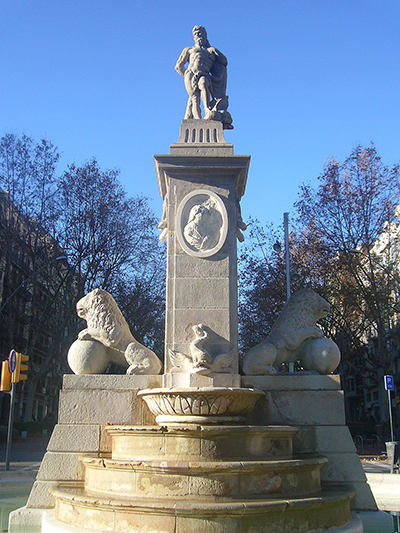Font d'Hèrcules is one of the little-known works by Antoni Gaudi. It was built in 1884, and it is based in the bamboo grove and the new Royal Palace of Barcelona. For a couple of years, this fountain was concealed from the vegetation, and its presence wasn’t revealed until 1984. It was discovered due to the major cleaning works that were being undertaken.
The fountain is crowned by the figure of Hercules, leaning on a stick, naked, and the skin of the Lion of Nemea in his left arm. An oval medallion containing a portrait of Charles IV and his dear wife Maria Luisa is located on the pedestal. Two lions also flank the pedestal on either side, and everything is set on a podium with steps in the centre of a circular pond.
The new Royal Palace of Barcelona date back in the 17th century and has its origin in the old farmhouse of Can Feliu. In 1862, the estate was acquired by Count Eusebi Güell, together with its neighbour. The two formed a large Güell estate measuring roughly 30,000 m². The architect Joan Martorelli Montells, who designed a Caribbean-style mansion, accompanied by a neo-Gothic chapel surrounded by superb gardens, was contracted to renovate the Can Feliu tower. Later, Antoni Gaudi was contracted to remodel the house and to build a fence wall as well as the goalkeeping pavilions.
Gaudí also partially took care of the design of the gardens of the property, building a pergola and two fountains, as well as planting various types of Mediterranean plants (pines, eucalyptus, palm trees, cypress and magnolia). In 1918, the garden and the house were awarded to the royal family. This was a symbol of thank you due to the respectable title given to him. 1919 and 1924, the house was remodelled by the architects Francesc Nebot and Eusebi Bona into a modern royal palace. The palace is founded on a four-storey high building, two-three storey high wings on the side that forms a beautiful curve whose front façade faces the front as well as a chapel that was behind.
The outside façade has Tuscan order columns that form round arches, two porches, jars, and medallions on the top. It is important to note that this facade is built in a style that took after the Noucentisme movement. The inner part of this building is designed with countless styles in decorations as in furniture; this ranged from the contemporary styles to the Louis XIV style. It was Nicolau Maria who designed the gardens. The designed comprised of lots of trees, a geometrically decorative area, as well as a pond that had several decorative elements. The design also included bamboo benches, Gaudi’s fountain, as well as 3 lighted fountains.
Carles Buïgas designed the Magic Fountain situated in Montjuïc and several other statues. One of the famous statues he designed is that of Queen Isabella II alongside her son Alfonso XII. The building was then made a royal palace in 1924, but in 1931, it was converted to become a property of the regional government upon the 2nd Spanish Republic's decree. In 1932, the city government determined to make the building a decorative arts museum. Franco used the building as his residence whenever he toured the city.




